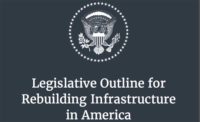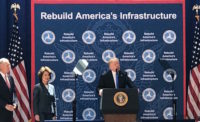Months of waiting for specifics about President Trump’s $1-trillion, 10-year infrastructure plan may be nearing an end. Trump has said he will mention the proposal in his State of the Union address on Jan. 30 and a key aide says more information will be sent to Capitol Hill within about two weeks after that.
Trump told a group of mayors at the White House on Jan. 24, “We’ll be talking about [infrastructure] a little bit in the State of the Union.” He also said that the White House would probably be putting out more information about the plan “in a week or two.”
After that, the focus will shift to Congress, which would have to turn the proposal into legislation, a process that is likely to stretch for months, at least. "That's really where the work will begin," notes Brian Pallasch, American Society of Civil Engineers managing director for government relations and infrastructure initiatives.
As they flesh out, and no doubt change, the White House proposal, House and Senate lawmakers are sure to want to put their marks on it and protect their states’ and districts’ interests.
D.J. Gribbin, special assistant to the president for Infrastructure, speaking on Jan. 25 at the U.S. Conference of Mayors’ winter meeting in Washington, D.C., that the plan will call for at least $200 billion in federal spending.
Counting non-federal dollars would bring the new investment total to $1 trillion. Trump even used a $1.7-billion figure.
Gribbin also said the plan “will not include new revenue.”
He said the administration is “neutral” about raising the federal gasoline tax. “We don’t support it,” he said. “We don’t oppose it either.”
Highway Trust Fund, SRFs
Gribbin added that the plan will leave untouched the Highway Trust Fund and State Revolving Funds for drinking water and wastewater-treatment projects, which he termed “major delivery mechanisms” for infrastructure funding.
But Denver Mayor Michael Hancock pressed Gribbin about possible cuts in other programs. Gribbin acknowledged that the administration will seek to “repurpose”—in other words, cut—funds for some existing programs.
Pallasch says, "It's unclear whether they're going to cut from infrastructure funding programs or whether they're going to cut from other federal programs."
Pallasch notes that the U.S. infrastructure funding gap now is about $2 trilion. He says that if the Trump proposal ends up including reductions in other infrastructure areas, "We have enough infrastructure issues to address with federal dollars that moving them from Program A to Program B is probably not going to solve the problem."
Gribbin noted proposals in Trump’s fiscal 2018 budget request, released last May. It called for cuts in transit new starts, Amtrak and the popular TIGER grants for a range of project types. Those proposals didn’t fly in Congress. He didn’t state that these specific programs’ fund would be repurposed in the 2018 plan.
Like other construction and engineering groups, the Associated General Contractors of America supports an increase in infrastructure funding. Brian Deery, senior director of AGC’s highway and transportation division, says, “We would be happy to see $200 billion in new infrastructure dollars come to the table.”
But he adds that the group hasn’t taken a position on the details of the proposed funding. But there’s one big exception. Deery says, “A fundamental piece of this should be fixing the existing programs, and that apparently is not going to be included.”
Specifically, he says, “You need to shore up the Highway Trust Fund. You can’t just let the Highway Trust Fund wither and die.”
The fund is expected to fall into a deficit, again, perhaps as early as 2020.
He also says AGC would like to see increased dollars for the water SRFs.
Gribbin told the mayors that the proposal has two “overarching” principles—increasing infrastructure investment by $1 trillion, and cutting federal permitting process to no more than two years.
He indicated that the administration has some flexibility. Gribbin said, “We are very open to ideas on how to accomplish those goals.” He added, “We don’t believe that we have all the answers.”
Mayors react
New Orleans Mayor Mitch Landrieu (D), said mayors want to work with the administration and Congress on the infrastructure issue. Landrieu added, “We think the cities are the place where a lot of this money ought to land because we’re doing [infrastructure improvements] now.”
Los Angeles Mayor Eric Garcetti (D), who chaired the session at which Gribbin spoke, told reporters, “There was more hopeful news [in Gribbin’s remarks] that dispelled some of the myths out there.” Garcetti added, “But I think there’s still a long way to go. They’re proposing stuff without filling in the ‘how.’ “
He said he appreciated that the administration is, at least, not opposed to some possible funding sources, such as the gas tax, and is willing to go above $200 billion.
Garcetti added that what’s needed is to begin to reduce the estimated $5.4-trillion national infrastructure gap. He said, “We really do see $200 billion as a start, and we should go big or go home.”
Lima, Ohio, Mayor David Berger said he was "skeptical" about the plan because it seemed to imply that cities weren't spending enough on infrastructure "and we need to be 'incentivized.'" Berger observed that cities already spend $118 billion annually on drinking-water and wastewater treatment.
He added that from 2001 to 2015, local governments and water districts invested almost $1.5 trillion on those water programs, more than 98% of all governmental spending on drinking-water and wastewater. "The federal contribution now is minimal," Berger said.
He added that many localities are at or near their borrowing limits and said that what's needed is an increase in federal water grant.
Possible outline leaked
Other details emerged in what is believed to be a six-page outline of the plan that was obtained by news organization Axios and published on Jan. 22. It was unclear, however, whether the outline represented the plan’s current shape or was an earlier version.
The leaked document states that half of the envisioned $200 billion would be for an “Infrastructure Incentives Initiative,” for surface transportation, airports, waterways, ports, drinking-water, stormwater, wastewater-treatment, Brownfield and Superfund projects.
Under the proposal, nonfederal governments, private entities and other organizations would apply to federal agencies for funding. The federal share would be no more than 20% of project costs
Rural projects would get 25% of the $200 billion total, or $50 billion, to be distributed to governors according to a formula that includes a state’s shares of total U.S. rural population and U.S. rural highway lane-miles.
Another category is “transformative” accounting for 10% of the total, or $20 billion. The summary defines transformative as “Exploratory and ground-breaking ideas that have more risk than standard infrastructure projects but offer a larger reward profile.”
Increases in federal loan programs, such as the Transportation Infrastructure Finance and Innovation Act, would get 7.05% of the total, or $14 billion.\
A new “Federal Capital Financing Fund” to finance purchases of federally owned non-military real estate would get 5%, or $10 billion.
Story expanded on 1/19/18 with comments from ASCE and Lima, Ohio, mayor.





Post a comment to this article
Report Abusive Comment